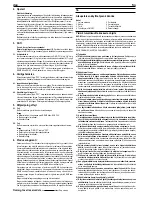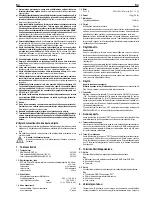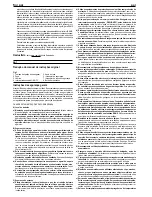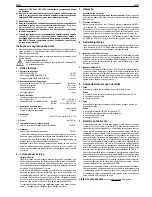
eng
eng / fra
another device. The indicated weighted effective value of acceleration can also
be used as a preliminary evaluation of the exposure.
Attention:
The indicated weighted effective value of acceleration can differ
during operation from the indicated value, dependent on the manner in which
the device is used. Dependent upon the actual conditions of use (periodic duty)
it may be necessary to establish safety precautions for the protection of the
operator.
2. Preparations for use
Electrical connection
Note the mains voltage! Before connecting the drive unit or the rapid charger,
check whether voltage on the rating plate matches the mains voltage. At work
sites, in damp surroundings, in the open or in the case of comparable types of
use, only operate the equipment off the mains using a 30mA fault current
protected switch (FI breaker).
Charge the battery before initial operation. Only use the supplied charger with
the cordless pipe shears the REMS Akku-ROS P 40. Insert the plug of the
charging unit into the socket (1) on the under side of the hand grip (2). Insert
the mains plug of the charging unit into the mains socket. Allow the battery 2
hours to charge. After charging unplug the mains plug first, then the plug from
the socket connecting the charger (1).
The battery reaches full capacity after several charges. The charger is not
suitable for use outside.
3. Operation
Warning, risk of injury!
Never grip in the area of the blade (3)!
There is a danger of losing your finger!
Keep hair, clothes and gloves well away from the cutting area.
3.1. Working procedure
Mark where the cut is to be made on the pipe. Slide switch “ON/OFF“ (4) should
be switched to the ”ON” position. Rest the pipe on the pipe support (5) and
press against the safety switch (6). Engage the safety tip switch (trigger) (7).
The blade (3) cuts through the pipe. After cutting the cordless pipe shears shuts
off automatically, as long as the safety tip switch (trigger) is released (6). By
pressing the return button (8) the blade (3) retracts.
Switch the slide switch to “OFF”, when you have finished using the REMS
Akku-ROS P 40. Charge the battery again ready for the next usage.
4. Maintenance
Before any maintenance or servicing switch the slide switch (4) to the ”OFF”
position! This work should be carried out only be service professionals and
trained personell.
4.1. Inspection/maintenance
The motor has carbon brushes, which are subject to wear. Therefore the cord-
less pipe shears must be inspected from time to time by an authorised REMS
service repair depot. The carbon brushes cannot be replaced, in which case
the motor would need to be replaced.
4.2. Replacing the blade (3)
Switch the slide switch (4) to the ”OFF” position! Place the cordless pipe shears
down so that the housing screws can be removed. Remove the upper housing.
Remove the fixing screw of the drive-unit and remove the drive-unit. Remove
the spring for the blade return. Remove all nuts of the blade holder, replace the
blade. Lightly oil moving parts.
5. Troubleshooting
5.1. Fault
Cordless pipe shears halt during cutting procedure.
Cause
● Material is not suitable for cutting with the REMS Akku-ROS P 40.
● Battery low or flat.
● Blade blunt.
5.2. Fault
Cordless pipe shears does not operate when safety tip switch (trigger) is
pressed.
Cause
● Safety switch ON/OFF is in the “OFF” position.
● Pipe is not in contact with the safety switch.
● Battery low or flat.
● Blade blunt.
6. Manufacturer’s Warranty
The warranty period shall be 12 months from delivery of the new product to the
first user but shall be a maximum of 24 months after delivery to the Dealer. The
date of delivery shall be documented by the submission of the original purchase
documents, which must include the date of purchase and the designation of
the product. All functional defects occurring within the warranty period, which
clearly the consequence of defects in production or materials, will be remedied
free of charge. The remedy of defects shall not extend or renew the guarantee
period for the product. Damage attributable to natural wear and tear, incorrect
treatment or misuse, failure to observe the operational instructions, unsuitable
operating materials, excessive demand, use for unauthorized purposes, inter-
ventions by the Customer or a third party or other reasons, for which REMS is
not responsible, shall be excluded from the warranty.
Services under the warranty may only be provided by customer service stations
authorized for this purpose by REMS. Complaints will only be accepted if the
product is returned to a customer service station autho rized by REMS without
prior interference in an unassembled condition. Replaced products and parts
shall become the property of REMS.
The user shall be responsible for the cost of shipping and returning the product.
The legal rights of users, in particular the right to claim damages from the
Dealer, shall not be affected. This manufacturer’s warranty shall apply only to
new products purchased in the European Union, in Norway or Switzerland.
Spare parts list
see www.rems.de under Downloads.
fra
Traduction de la notice d’utilisation originale
Remarques générales pour la sécurité
ATTENTION !
Toutes les directives doivent être lues. Le non-respect des instructions
présentées ci-après peuvent entraîner un risque de décharge électrique, de brûlures
et/ou d’autres blessures graves. Le terme utilisé ci-après « appareil électrique » se
réfère aux outils électriques sur secteur (avec câble de réseau), aux outils électriques
sur accu (sans câble de réseau), aux machines et aux outils électriques. N’utiliser
l’appareil que pour accomplir les tâches pour lesquelles il a été spécialement conçu
et conformément aux prescriptions relatives à la sécurité du travail et à la prévention
des accidents.
CONSERVER PRECIEUSEMENT CES INSTRUCTIONS
A) Poste de travail
a) Maintenir le poste de travail propre et rangé.
Le désordre et un poste de travail
non éclairé peut être source d’accident.
b) Ne pas travailler avec l’appareil électrique dans un milieu où il existe un
risque d’explosion, notamment en présence de liquides, de gaz ou de
poussières inflammables.
Les appareils électriques produisent des étincelles,
qui peuvent mettre le feu à la poussière ou aux vapeurs.
c) Tenir les enfants et des tierces personnes à l’écart pendant l’utilisation de
l’appareil électrique.
Il y a un risque de perte de contrôle de la machine en cas
de distraction.
B) Sécurité électrique
a) La fiche mâle de l’appareil électrique doit être appropriée à la prise de
courant. La fiche mâle ne doit en aucun cas être modifée. Ne pas utiliser
d’adaptateur de fiche mâle avec un appareil électrique avec mise à la terre.
Des fiches mâles non modifiées et des prises de courant appropriées réduisent
le risque d’une décharge électrique. Si l’appareil est doté d’un conducteur de
protection, ne brancher la fiche mâle que sur une prise de courant avec mise à
la terre. Sur chantier, en plein air ou sur un autre mode d’installation, n’utiliser
l’appareil électrique qu’avec un dispositif de protection à courant de défaut de
30 mA (déclencheur par courant de défaut) sur réseau.
b) Eviter le contact avec des surfaces avec mise à la terre, comme les tubes,
radiateurs, cuisinières et réfrigérateurs.
Il y a un risque élevé de décharge
électrique lorsque le corps est en contact avec la terre.
c) Tenir l’appareil électrique à l’écart de la pluie ou de milieux humides.
La
pénétration d’eau dans un appareil électrique augmente le risque de décharge
électrique.
d) Ne pas utiliser le câble pour des fins auxquelles il n’a pas été prévu, notam-
ment pour porter l’appareil, l’accrocher ou pour débrancher l’appareil en
tirant sur la fiche mâle. Tenir le câble éloigné de la chaleur, de l’huile, des
angles vifs et des pièces de l’appareil en mouvement.
Des câbles endom-
magés ou emmêlés augmentent le risque de décharge électrique.
e) Si vous travaillez avec l’appareil électrique à l’extérieur, n’utiliser que des
rallonges autorisées pour les travaux à l’extérieur.
L’utilisation d’une rallonge
appropriée pour l’extérieur réduit le risque de décharge électrique.
C) Sécurité des personnes
a) Etre attentif, veiller à ce que l’on fait et se mettre au travail avec bon sens
si l’on utilise un appareil électrique. Ne pas utiliser l’appareil électrique en
étant fatigué ou en étant sous l’influence de drogues, d’alcools ou de
médicaments.
Un moment d’inattention lors de l’utilisation de l’appareil peut
entraîner des blessures graves.
b) Porter des équipements de protection individuelle et toujours des lunettes
de protection.
Le port d’équipements de protection individuelle, comme un
masque respiratoire, des chaussures de sécurité anti-dérapantes, un casque de
protection ou une protection acoustique selon le type de l’utilisation de l’appareil
électrique, réduit le risque de blessures.
c) Eviter toute utilisation involontaire ou incontrôlée. Veiller à ce que l’inter-
Fig. 1
1 Fiche femelle de raccordement
chargeur
2 Poignée
3 Lame
4 Interrupteur à glissière ON/OFF
5 Support du tube
6 Capteur de sécurité
7 Interrupteur à gachette
8 Bouton retour de la lame







































